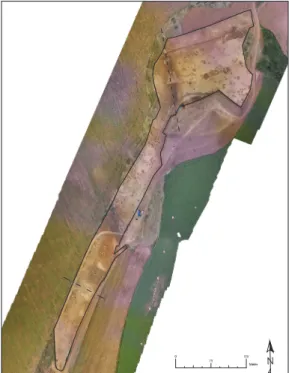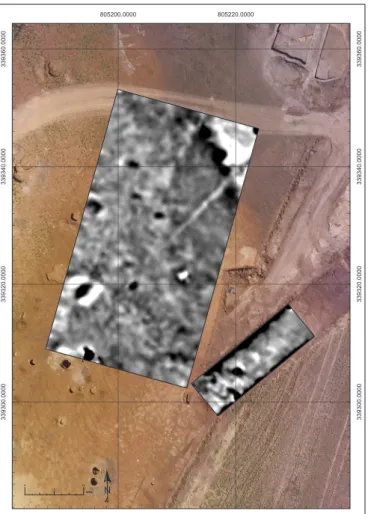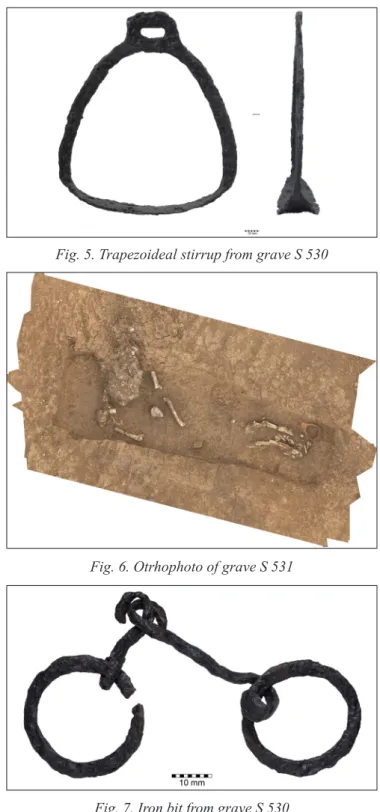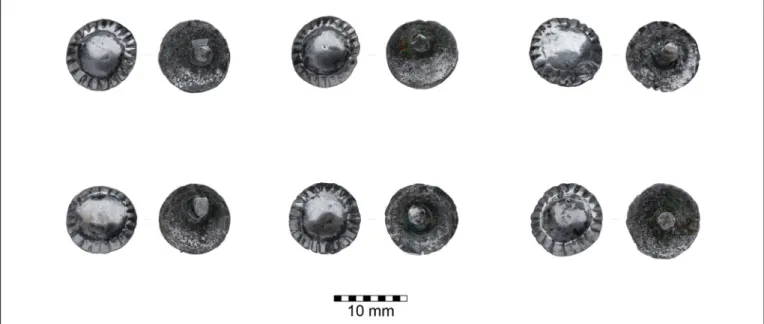THE CONQUERORS OF THE HERNÁD VALLEY – DETAILS FROM THE HISTORY OF A REGION
Csilla libor – riChárd TakáCs
Hungarian Archaeology Vol. 8 (2019), Issue 3, pp. 28–34, https://doi.org/10.36338/ha.2019.3.9
Research into the 10th–11th century history of the Carpathian Basin has regained great impetus in the last dec- ade. There are fewer and fewer blank spots in connection with this period as recent excavations have been able to shed light on the history of certain minor regions during this era. At the same time, the research has not come close to being completed, and every excavation contributes another piece of the mosaic to the overall picture.
Szalaszend is one of the first archaeological sites of the Conquest period that has not been discovered through agricultural work, but during excavation, in a region, the Hernád Valley, that has been less understood up to now.
Due to this, it is supplying a great deal of new information to researchers about both the period and the region.
The preventive archaeological excavations related to phase C of the M30 expressway’s construction began in the spring of 2018 (Fig. 1). The recently established Hungarian National Museum’s Directorate of Archaeology and Heritage Preservation has begun the excavations at full capacity along the right-of-way of the road under construction. The first grave from the Conquest period was discovered in the autumn of 2017 at the Szalaszend – Nagy- és Kishegy site in an area to the south of a Bronze Age earthwork.
As the archaeologist of the Herman Ottó Museum, Tamás Pusztai performed a trial excavation for the preparation of the prelimi- nary archaeological documentation related to the project.
Following this, six Conquest period graves were found in 2018, alongside 650 Bronze Age and Iron Age features dur- ing the preventive excavation on an area of 22,000 m2 (Fig. 2).
The site lies on a hill in the Hernád Valley, which had been surrounded by ravines that are today no longer visible on the surface (Figs. 3–4). The 10th century materials were only rep- resented by these burials, which were on the banks of one of the aforementioned ravines.
Fig. 1. Szalaszend in Borsod County
Fig. 2. Orthophoto of the site
Méter 0
75 150
BURIAL RITE
The burials in the 10th century cemetery section of Szalaszend Kis- és Nagy-hegy are oriented east-west and are arranged in two rows of graves. The graves are in the shape of rounded rectangles and were rela- tively shallow.1 The interpretation of the site is made difficult by the fact that the graves were looted rela- tively soon after burial. Their infill was almost identical to the subsoil. The grave marks themselves were not visible and they were only discovered due to the looters’ pits. The looters intentionally dug towards the upper bodies, which means that the indications of the graves were still visible, but the bodies had already decomposed because no anatomical relationship could be discerned amongst the scattered bones.
EQUESTRIAN BURIALS
The various forms of equestrian burials throughout the Carpathian basin can be considered universal in the 10th century. Horse bones were also found alongside the material remains in three of the Szalaszend graves.
In the case of one of the women’s graves for example, shinbones from a horse were discovered, which is characteristic of the skinned horsehide burials of the Conquest period, and in the case of grave 1 excavated in 2017, a horse skull was found in addition to shinbones. This means that only the skull and legs of the horse were placed in the grave along with the skinned horsehide, as was customary for the time. The height of the horses at the withers was short (about 138–142 cm tall), as was characteristic of Conquest-period Hungarians, and there were no significant differences in measurements of the horse bones found in the men’s and women’s burials.2 It was only possible to observe the precise location of the horse bones in the case of
1 Bones already appeared at a depth of 3–5 cm from the surface after the humus layer was removed.
2 The archaeozoological examination was performed by Fruzsina Fekete. I would hereby like to thank her for her work.
Fig. 4. The geophysical survey indicated no further graves in the area Fig. 3. Position of the graves beside the ravine
2 3
Méter
0 5 10
805200.0000 805220.0000
805200.0000 805220.0000
339300.0000339320.0000339340.0000339360.0000
339300.0000339320.0000339340.0000339360.0000
the aforementioned woman’s grave, S 679. They probably were positioned at the feet of the deceased. One other interesting detail in connection with this was that evidence of major joint inflammation was visible on the horse bones placed alongside the man excavated in grave 1, which may indicate that this horse may have already hardly been able to walk. Thus, the question arises whether it was placed in the grave because it was the horse of the deceased man, who was already considered elderly at the time (maturus, 40-60 years old3), and so the similarly old and sick horse was laid beside him? Or was it just a horse in their corral that was no longer of use and would have been difficult to transport and so they sacrificed it during the funeral?
EQUESTRIAN EQUIPMENT Finds indicating equestrian equipment (harness
buckles, bits, stirrups) were discovered in several graves.
One of the most important elements of equestrian equipment is the stirrup. These were found in two of the graves at the site. In S 530, there was a trapezoidal stirrup (Fig. 5), while in S 531 a pear-shaped example came to light (Fig. 6). We also identified a scattered find discovered near SNR 530 in the sub-humus as a stirrup. Based on this fragment, it may hypothetically have belonged to a pear-shaped stirrup.
It can be taken into consideration that during bur- ial only one stirrup was placed next to the deceased.
At the same time, it is conceivable that the other stirrup was made of organic material that has left no trace. Perhaps one may have disappeared as a result of contemporary disturbances. However, due to the great deal of looting of the graves and the relatively small number of them, it is not possible to provide an explanation.
Pear-shaped stirrups were widespread throughout the 10th century in the Carpathian Basin, so they are not useful for more precise dating within the period.
Trapezoidal stirrups appeared in the middle third of the 10th century (Révész, 1996, p. 46), but only became widespread in the second half of the century (Révész, 1996, p. 45).
The internal height of the stirrups is relatively small (ranging between 105 and 119 mm). According to the agreeing opinions of István Dienes (Dienes, 1966, p.
231) and László Révész (Révész, 1996, p. 43), this was characteristic primarily of women and highborn men that were less proficient at riding. The narrower stirrups were safer, since if the rider were to fall from the horse their leg would not get stuck/caught in it.
The most important tool for steering a horse is the bit. In our section of the cemetery, two burials contained bits. Both examples belong to the cate-
3 Antónia Marcsik examined the male skeleton found during the 2017 trial excavation.
Fig. 5. Trapezoideal stirrup from grave S 530
Fig. 7. Iron bit from grave S 530 Fig. 6. Otrhophoto of grave S 531
gory of two-ringed, jointed snaffle bits. In S 530 the bit was asymmetrical (Fig. 7), while the bit in S 679 had a symmetrical mouthpiece. The two types were generally widespread and have no value for more pre- cise dating. Based on the size of the rings, both examples belong to the category of small-ringed bits.
Bits with symmetrical mouthpieces made it possible to steer the horses more easily. They were the tools of less experienced riders, similar to the narrow stirrups. Bits with asymmetrical mouthpieces were used by warri- ors and herdsmen, who did not always have the ability to hold the reins with both hands (Dienes, 1966, p. 220).
Only S 531 contained a harness buckle used to secure the saddle. It is rectangular, and its prong had rusted to the frame.
JEWELRY
In the case of the Szalaszend cemetery section, objects that can be interpreted as jewelry were found in two graves.
Head jewelry is represented by circular jewelry, which was present in graves S 489 and 679. Both exam- ples were round, open, circular silver jewelry made from thin wire (1–2 mm). This type was widespread throughout the Carpathian Basin in the 10th century, but it went out of style at the end of the century and did not last to the 11th century (Szőke&Vándor, 1987, p. 54).
There was a single fragment from grave S 679 that could be interpreted as a highly damaged glass bead with a horizontally sectioned form and categorized as jewelry for the neck.
ITEMS OF APPAREL Three graves in the cemetery section contained finds indicating apparel (ball buttons, belt mountings, clothing ornaments, buckles).
A total of five ball buttons were found in graves S 489 and S 679.
The buttons from S 489 belong to an identical type. All three examples are hollow bronze comprised of two parts, with the shank connected to the button by a ringed element. The buttons of S 679 represent two different types (Fig. 8). One is solid, silver-plated and round, while the other is an undecorated bronze example made from two halves fitted together.
Besides using buttons, upper-body apparel could also be fastened with belts. Relics of this survived in two burials at the site. In each grave, a buckle and a metal plate that could be interpreted as a mounting
Fig. 9. Silver mounts from grave S 679
Fig. 8. Silver-plated bronze ball button from grave S 679
were found. The mounting discovered in grave S 407 below the pelvic bone belongs to the category of square mountings. This type of mounting is characteristic of the 10th century and is primarily found in female burials (HorVátH, 2004, p. 161). There was a square iron buckle with rounded corners in grave S 679. This buckle form was universally widespread in the 10th–11th century and is not able to provide more precise dating.
It is only the six round clothing ornaments from the soil of grave S 679 that can be clearly interpreted as clothing ornaments (Fig. 9). Each of these is identical in appearance. A ring can be found at the middle of these semicircular mounts. The area between the ring and the edge is filled with incised radiating grooves.
They were affixed with rivets.
WEAPONRY Only archery equipment represents the weaponry here.
During the washing of the skeletal bones of S 407 an oval bone grip was discovered. Its pair was not discov- ered. Its precise location within the grave is not known.
Bone fittings for a bow were also found in S 489. In this case, an oval bone grip was also discovered as well as a fragment of the bow limb veneer.
In grave S 489, there were also iron fragments that could be interpreted as bracing rods for a quiver and a convex rectan- gular bone quiver lid that also had iron rods rusted to it (Fig.
10). Quivers with (undecorated) bone lids are known from throughout the 10th century – although not in large numbers – and cannot be dated by themselves (Straub, 1999, p. 410).
These quivers are concentrated in the southern Great Hungar- ian Plain for the most part, and are rare to the north of the line of the Körös rivers (Straub, 1999, fig 2. 1). In the vicinity of our site, examples are only known from the Karos-Eper- jesszög II cemetery (Révész, 1996, pp. 18, 27–28, 30).
An iron knife with a central grip location was discovered in grave S 679, which cannot be definitively interpreted as a weapon, but is worthy of note.
FUNERARY OBOL
The use of funerary obols during the 10th century is a phenomenon that is generally known, but not too com- mon. In its original meaning, an obol is a coin that is placed in the mouth of the deceased during the funeral.
However, here one of the coins was discovered in the eye socket. Coins that can be interpreted as obols were only found in grave S 679 of the Szaleszend cemetery section. Both denarii were minted during the reigns of
Fig. 10. Bow limb veneer made from bone, from grave S 489
Fig. 11. First coin from grave S 679 Fig. 12. Second coin from grave S 679
Hugh and Lothair II (931–947), and belong to the HNI 1/9 type (Figs. 11-12). In the present case, it is only conditionally possible to talk about these two coins being present in the grave as obols. Unfortunately, due to disturbances only one of the coins was located in the eye socket (Fig. 13). However, the skull itself was also not located in its proper anatomical position, since it was in the middle of the grave near the pelvis and turned upside down. The other coin was located on the right shinbone near the inner side in the middle section of the bone. However, this positioning can be explained by it having fallen towards the legs when the head was tossed over. Unfortunately, there is no proof for this, but it is an important fact in any case that there were two coins in this grave and one of them was actually found in the eye socket of the corpse.
ASSESSMENT
As a result of the great deal of disturbance, the precise period of use of the cemetery section cannot be determined. On the basis of the surviving finds that can be dated, it can be placed in the middle-last third of the 10th century. At the same time, due to the equestrian burials and the simple circular jewelry, it probably does not extend into the 11th century.
Even despite the looting of the graves in the Szalaszend cemetery section, they provide a great deal of information to us (for example, they provide data on the range of quivers with bone lids), and from this it became apparent that this region may have been an important area in the Conquest period as well. Despite all of this, the research on this micro-region is still in an early phase because a significant portion of the 10th–11th century relics from the area are scattered finds or are from uncertified excavations. The graves fit in well with the profile created by the 10th century sites found in the broader surroundings. The cemetery site may have continued to the west, and there may be a possibility to study this in the future. However, until then it is worthwhile to take advantage of the opportunities provided by the M30 expressway as best as possible and to understand the history of the entire micro-region more precisely.
bibliograpHy
dieneS, i., 1966.
A honfoglaló magyarok lószerszámának néhány tanulsága. Archaeologiai Értesitő 93, 208–237.
iStVánoVitS, E., 2003.
A rétköz honfoglalás és Árpád-kori emlékanyaga. Régészeti gyűjtemények Nyíregyházán 2. Magyarország honfoglalás és kora Árpád-kori sírleletei 4. Nyíregyháza: Jósa András Múzeum, 2003
Fig. 13. Orthophoto of grave S 679 Fig. 14. The location where the coin shown in Fig. 11 was found
HorVátH, C., 2004.
Adatok a honfoglalás kori kő- és üvegbetéttel díszített fegyverek, tarsolyok és veretek kérdésköréhez.
Communicationes Archaeologicae Hungariae 2004, 151–171.
Révész, L., 1996.
A karosi honfoglalás kori temetők. Régészeti adatok a Felső-Tisza-vidék X. századi történetéhez.
Magyarország honfoglalás kori és kor Árpád-kori sírleletei 1. Miskolc: Herman Ottó Múzeum, 1996.
Straub, P., 1999.
A honfoglalás kori tegezcsontok időrendjéhez. Móra Ferenc Múzeum Évkönyve – Studia Archaeologica 5, 409–422.
Szendrey, Á., 1928.
Az ősmagyar temetkezés. Ethnographia 34, 12–26.
Szőke, b. M. & Vándor, l., 1987.
Pusztaszentlászló Árpád-kori temetője. Fontes Archaeologici Hungariae. Budapest: Akadémiai Kiadó, 1987.
tettaManti, S., 1975.
Temetkezési szokások a X-XI. században a Kárpát-medencében. Studia Comitatensia 3, 79–123.





